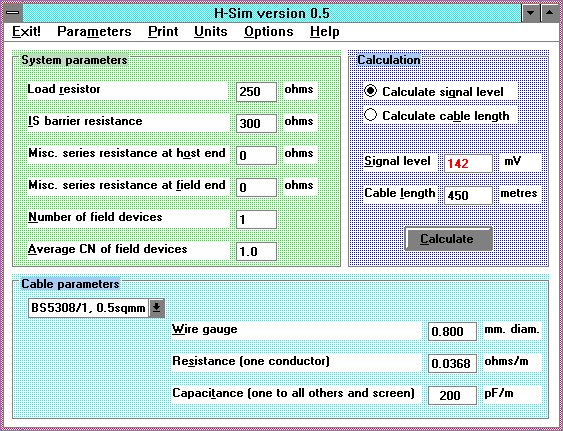Romilly's HART® and Fieldbus Web Site
HART cable lengths: H-Sim
Copyright © Romilly Bowden 1996 - 1998.
The HART protocol is designed to work over existing analogue signal cables. But there are limits to how far it can go. The length of cable which can be used reliably depends on several factors. The main ones are:
- Loop load resistance
- Cable resistance
- Cable capacitance
- Number and capacitance of field devices
- Resistance and position of other devices in the loop.
Essentially, the requirement is that the network should pass the HART signal frequencies (1200 and 2200 Hz) without too much loss or distortion. The two main causes of loss are resistance (causing loss at all frequencies) and capacitance (causing loss at higher frequencies).
HART signal levels and receiver thresholds are specified in such a way as to allow for some loss, down to 0.66 of the current signal from a field device to a minimum-load master, or down to 0.3 of the voltage signal from the master to a field device.
As well as having sufficient signal amplitude, it is important that the two different frequencies making up the HART signal should be passed more or less equally well, to avoid phase distortion which could make the signal hard to decode. To assure this, the bandwidth of the network should be at least 2500Hz. This is the basis of the "65-microsecond rule", which says that the product of the network resistance and capacitance should be less than 65 microseconds.
To determine the signal loss in a real network is easy enough, using an oscilloscope to inspect the actual signal levels. But to predict it in advance is not so easy. H-Sim is a Windows (3.0 or higher) program which solves a set of equations, representing a simplified model of a HART communication network. You may therefore find H-Sim useful in helping you design HART networks. However, you must ensure that the representation is adequate for your application. The User Manual gives full information about the equations and the circuit model.
You can use H-Sim to predict the signal level for a particular cable type and length, or to calculate the possible cable length which will still give a desired signal level. You should also apply the 65-microsecond rule to ensure that the network bandwidth is adequate. (A future version of H-Sim may include this check.)
H-Sim takes account of shunt diode ("zener") barriers used in intrinsic safety (IS) applications, but does not deal with IS networks using active isolators or repeaters.
H-Sim is copyright, but the current version, H-Sim 0.5, is offered here free of charge.
When it's running, the main screen looks like this:

Before you download H-Sim, please fill in this short registration form. There are two reasons for this:
- I would like to know how many people take advantage of this download.
- If I know who has a copy of H-Sim, I can let you know about updates.
Thank you.
Now ...
- Download HSIM05.EXE now into an empty directory.
- Check the file size. It should be 294,468 bytes. If it's wrong, the download failed; try again.
- Run it, which expands it into the full H-Sim file set, in the same directory.
- Then run SETUP.EXE, which installs H-Sim and its associated files into another directory of your choice (C:\HSIM is the default, but you can choose something else).
The README.TXT file gives further information about installation. (The README file assumes you have H-Sim on a floppy disk, but you can just as well install it from its download directory on a hard disk, to another directory on the same or another hard disk.) After you have installed H-Sim successfully, you could well delete the download directory and all its contents.
The User Manual is included, as a Write document. You are strongly encouraged to print it out and read it!
By all means return the full registration form in the User Manual eventually, as well, and let me know how you find the product. E-mail is fine for that too, of course.
If you have any difficulty with downloading or installing H-Sim, please e-mail me.
New revisions of H-Sim will also appear here from time to time.
Home Top of page Consultancy